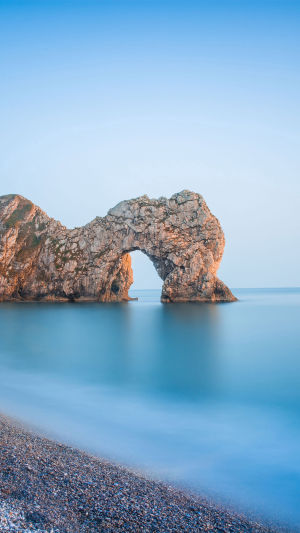The Durdle Door is a natural limestone arch situated on the Jurassic Coast in Dorset, formed by the erosion of soft rock by the sea over time.
It is one of the Jurassic Coast's most famous attractions, with around 200,000 people walking the path through Durdle Door and Lulworth Gorge each year, making Durdle Door one of the busiest places on the southwest coast of England.
Next to Durdle Door is a long stretch of beach, where visitors can sit on a quiet beach and watch the tide rise and fall, and see the magnificent view of Durdle Door.
The Durdle Door is made of hard Portland limestone, but as the waves pound it over time, It is destined to one day eventually collapse.
A natural arch is a naturally occurring geological phenomenon.
Natural channels caused by water erosion and weathering pass beneath the rock, eventually forming an arch-shaped rock formation.
Natural arches are usually formed in places that are susceptible to erosion by seawater, rivers, or weathering, such as coasts, narrow ridges, and thin walls of cliffs.
The process of erosion specifically "seeks out" and "selects" weak spots in the rock to "attack" until long-term erosion cuts through the rock and opens a natural channel in the rock. This results in a variety of arches.
Like all rock formations, natural arches will continue to be eroded after they are formed and eventually collapse and disappear.
The process of formation and collapse of water erosion arches is rough as follows: some small cracks develop in-depth and penetrate into the sandstone layer; water flow and weathering erosion wear down the exposed rock layer and widen the surface cracks.
Alternating action of ice frost and ice melt causes porous sandstone to crumble and spall, and in some cases to be cut through, as a result, forming arches or arch bridges.
The rock crumbled and weathered, and the arch passage grew larger and larger, eventually leading to a collapse with only the piers left.
In addition to the Dudel Gate, the world is home to a number of beautiful natural arches.
Including the Dove Rock in Lebanon, the Arch of Pondarque in Paris, the Arc de Triomphe of Cabo San Lucas in Mexico, and the London Arch in Australia.
Today, only a portion of Australia's London Arch remains and is no longer a complete double-headed bridge, but it is still spectacular.
The Arches National Park in the United States is undoubtedly the most famous arch-gathering place with a large number of arches and strange shapes, attracting countless tourists to come and see them, so if you are interested in natural arches, you may want to visit them there.





